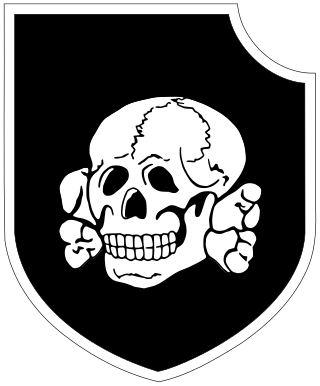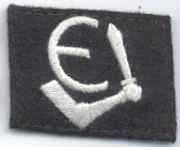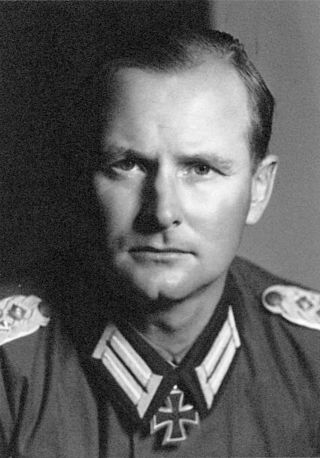Related Research Articles

The Waffen-SS was the combat branch of the Nazi Party's paramilitary Schutzstaffel (SS) organisation. Its formations included men from Nazi Germany, along with volunteers and conscripts from both occupied and unoccupied lands.

The Malmedy massacre was a German war crime committed by soldiers of the Waffen-SS on 17 December 1944 at the Baugnez crossroads near the city of Malmedy, Belgium, during the Battle of the Bulge. Soldiers of Kampfgruppe Peiper summarily killed eighty-four U.S. Army prisoners of war (POWs) who had surrendered after a brief battle. The Waffen-SS soldiers had grouped the U.S. POWs in a farmer's field, where they used machine guns to shoot and kill the grouped POWs; the prisoners of war who survived the gunfire of the massacre then were killed with a coup de grâce gun-shot to the head.

Joachim Peiper was a German Schutzstaffel (SS) officer and war criminal convicted for the Malmedy massacre of U.S. Army prisoners of war (POWs). During the Second World War in Europe, Peiper served as personal adjutant to Heinrich Himmler, leader of the SS, and as a tank commander in the Waffen-SS. Peiper personified Nazi ideology as a purportedly ruthless glory-hound commander who was indifferent to the combat casualties of Battle Group Peiper, and who encouraged, expected, and tolerated war crimes by his Waffen-SS soldiers.

The 63rd Infantry Division was an infantry division of the United States Army that fought in Europe during World War II. After the war it was inactivated, but later the division number and shoulder sleeve insignia were authorized for use by the 63rd Army Reserve Command (ARCOM).
The Panzergrenadier Division "Großdeutschland", also commonly referred to simply as Großdeutschland or Großdeutschland Division, was an elite combat unit of the German Army that fought on the Eastern Front in World War II.

The SS Division Hitlerjugend or 12th SS Panzer Division "Hitlerjugend" was a German armoured division of the Waffen-SS during World War II. The majority of its junior enlisted men were drawn from members of the Hitler Youth, while the senior NCOs and officers were from other Waffen-SS divisions.

The 3rd SS Panzer Division "Totenkopf" was an elite division of the Waffen-SS of Nazi Germany during World War II, formed from the Standarten of the SS-TV. Its name, Totenkopf, is German for "death's head" – the skull and crossbones symbol – and it is thus sometimes referred to as the Death's Head Division.

Kurt Meyer was an SS commander and convicted war criminal of Nazi Germany. He served in the Waffen-SS and participated in the Battle of France, Operation Barbarossa, and other engagements during World War II. Meyer commanded the 12th SS Panzer Division Hitlerjugend during the Allied invasion of Normandy, and was a recipient of the Knight's Cross of the Iron Cross with Oak Leaves and Swords.

The Dirlewanger Brigade, also known as the SS-Sturmbrigade Dirlewanger (1944), or the 36th Waffen Grenadier Division of the SS, or The Black Hunters, was a unit of the Waffen-SS during World War II. The unit, named after its commander Oskar Dirlewanger, consisted of convicted criminals who were not expected to survive their service with the unit. Originally formed in 1940 and first deployed for counter-insurgency duties against the Polish resistance movement, the brigade saw service in anti-partisan actions in German-occupied Eastern Europe.

The 29th Infantry Division was a unit of the German army created in the fall of 1936. It was based on the old Reichswehr 15th Infantry Regiment and drew its initial recruits from Thuringia. It was upgraded to 29th Motorized Infantry Division in the fall of 1937. The division was also known as the Falke-Division.

The 17th SS Panzergrenadier Division "Götz von Berlichingen" was a German Waffen-SS division that saw action on the Western Front during World War II.

The 20th Waffen Grenadier Division of the SS was a foreign infantry division of the Waffen-SS that served alongside but was never formally part of the Wehrmacht during World War II. According to some sources, the division was under Reichsführer-SS Heinrich Himmler's overall command but was not an integral part of the Schutzstaffel (SS). It was officially activated on 24 January 1944, and many of its soldiers had been members of the Estonian Legion and/or the 3rd Estonian SS Volunteer Brigade, which had been fighting as part of German forces since August 1942 and October 1943 respectively. Both of the preceding formations drew their personnel from German-occupied Estonia. Shortly after its official activation, widespread conscription within Estonia was announced by the German occupying authorities. The division was formed in Estonia around a cadre comprising the 3rd Estonian SS Volunteer Brigade, and was initially known as the 20th Estonian SS Volunteer Division.

Franz Friedrich Böhme was an Army officer who served in succession with the Austro-Hungarian Army, the Austrian Army and the German Wehrmacht. He rose to the rank of general during World War II, serving as Commander of the XVIII Mountain Corps, Hitler's Plenipotentiary Commanding General in the Balkans, and commander-in-chief in German-occupied Norway during World War II. After the war, Böhme was transferred to U.S. custody as a defendant in the Hostages Trial on charges of having massacred thousands of Serbian civilians. He committed suicide in prison.

Fritz Witt was a Waffen-SS commander during the Nazi era. During World War II, he served with the SS Division Leibstandarte before taking command of the SS Division Hitlerjugend. He was killed in action in June 1944.
The Chenogne massacre was a war crime committed by members of the 11th Armored Division, an American combat unit, near Chenogne, Belgium, on January 1, 1945, during the Battle of the Bulge.

The Ciepielów massacre that took place on 8 September 1939 was one of the largest and best documented war crimes of the Wehrmacht during its invasion of Poland. On that day, the forest near Ciepielów was the site of a mass murder of Polish prisoners of war from the Polish Upper Silesian 74th Infantry Regiment. The massacre was carried out by soldiers from the German Army's 15th Motorized Infantry Regiment, 29th Motorized Infantry Division, under the command of Colonel Walter Wessel.

The 24th Waffen Mountain Division of the SS "Karstjäger" was a German mountain infantry division of the Waffen-SS, the armed wing of the German Nazi Party that served alongside, but was never formally part of, the Wehrmacht during World War II. At the post-war Nuremberg trials, the Waffen-SS was declared to be a criminal organisation due to its major involvement in war crimes and crimes against humanity. Named Karstjäger, the formation was one of the 38 divisions fielded by the Waffen-SS. Formed on 18 July 1944 from the SS Volunteer Karstwehr Battalion, its nominal strength was never more than theoretical and the division was soon reduced to the Waffen Mountain (Karstjäger) Brigade of the SS. Throughout its existence as a battalion, division and brigade, it was primarily involved in fighting partisans in the Karst Plateau on the frontiers of Yugoslavia, Italy, and Austria; the mountainous terrain required specialised mountain troops and equipment.
48.897°N 10.253°E

The Zambrów massacre was a war crime that took place on the night of 13–14 September 1939. It was one of the major war crimes of the Wehrmacht during the invasion of Poland. During that night, the makeshift prisoner-of-war camp in Zambrów was disturbed by a number of panicked horses, and more than 200 Polish soldiers, trying to move out of their way, were gunned down by German sentries. Some witnesses later said the horses had been purposely released into the camp by the German sentries, who used the incident as a pretext to massacre the prisoners.

The Infantry Division Ulrich von Hutten was an infantry division of the German Wehrmacht during World War II, comprising the Army (Heer), Navy (Kriegsmarine), and Air Force (Luftwaffe). The Wehrmacht had numerous divisions, including infantry, armored, and other specialized units, which were involved in various military campaigns throughout the war. It was formed at the end of March 1945, just over a month before the end of the war. The division was named after German Protestant reformer Ulrich von Hutten (1488–1523).
References
- Henke, Klaus-Dietmar (1996). Die amerikanische Besetzung Deutschlands (in German). Munich: R. Oldenbourg Verlag. ISBN 3-486-56175-8.
- Zigan, Harald (16 April 2015). "Kriegsende 1945 (Teil 10): US-Soldaten nehmen blutige Rache in Jungholzhausen und Ilshofen". swp.de (in German). Archived from the original on 2019-03-06. Retrieved 29 September 2022.